Metalliferous Hills

Massa Marittima is the historical capital of the mining territory of the Metalliferous Hills. As of the medieval period, the wealth of minerals extracted on its territory permitted the city to adorn itself with civil and religious buildings that had nothing to envy of the greatest centres of the epoch. Today, the local system of museums valorises the artistic and scientific tokens of its glorious past.
The millenarian history of mining activity can be retraced starting from a visit to the Museo Civico Archeologico which houses exhibits from the nearby mining village of Accesa.
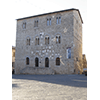
Overlooking one of the loveliest plazas in Italy, the Palazzo del Pretorio has housed the Massa Marittima Archaeological Museum since 1867. The first information on the Palazzo is found, according to the local historian Luigi Petrocchi, in a "contract stipulated in 1231 between the Podestà of the time and a certain Jacobo, a Lombard master marble-worker". The austere palazzo built of travertine, enlivened by mullioned windows and coats of arms, still conserves on its facade the metal bar known as the "step", utilised since 1586 as one of the Commune's standard units of measurement.
Although the Museum's importance is basically historical-archaeological, elements of notable scientific interest are to be found in its collections. On the ground floor, in fact, in addition to a historic collection of archaeological findings, there is a fine group of ceramic materials coming from the local antique pharmacy "Dr. Bernardino Mencacci": in particular, decorated jars, bearing inscriptions of the medicinal substances they contained (Wormwood, Bolus, Senna), along with some sixteenth-century pharmaceutical albarellos (some of the objects will be moved to the new museum of religious art at San Pietro all'Orto).
On the upper floors are archaeological materials coming from the research conducted from 1980 to the present at the nearby Lake of Accesa. Vases, jewellery and utensils for spinning, accompanied by explanatory panels and plastic models, illustrate the daily life of the ancient village.
In addition to learning about Etruscan building techniques, visitors are introduced to the difficult art of weaving in the ancient world, thanks to a loom carefully reconstructed on the basis of archaeological findings and iconographic models. It is a straight loom, made of oakwood, and equipped with the terracotta weights (originals) that served to stretch the threads downward. During an exhibition held in Prato in 1996, the loom's operation was tested by using it to weave a piece of linen cloth, with thread count and weft density similar to that of some fragments of fabric found in Etruscan tombs.
(Elena Fani)
The development of mining activity through the following centuries is instead illustrated by the collections of the Museo di Arte e Storia delle Miniere, which houses tools and documents, also concerning more recent epochs.
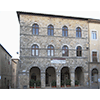
The first nucleus of the Museum was born in the early 1970s by initiative of the Massa Marittima Mineralogical Group. In 1984, the collections were placed in the fifteenth-century Palazzetto delle Armi, placed at the Museum’s disposal by the Commune, and opened to the public the following year. On the occasion of structural interventions to the building, in 1998 the Museum was completely redesigned and opened again in 2001. Along with the Mining Museum, the Museum of Mining Art and History belongs to the Museum System of Massa Marittima, created by the Communal Administration and run by the Cooperativa Colline Metallifere.
The Palazzetto looks out onto the Candeliere tower. It has four rooms that host a rich photographic and cartographic documentation, a collection of minerals from the Metalliferous Hills, and a collection of mining instruments which include mining tools of various epochs (from antiquity to the 20th century), and objects tied to the everyday life of miners (work clothes, metal baskets for food). Also particularly interesting are the panels with the mining history of the area, the reproduction of the Massa Marittima Mining Code that regulated mining activity, and the wooden reconstruction of a headframe for a mineshaft.
(Stefania Mangia)
Alternatively, you can visit another museum tied to the area’s mining activity that presents the faithful reconstruction of a mine, created in the air-raid shelters used during World War II.
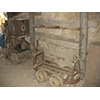
As nineteenth-century historian and naturalist Emanuele Repetti writes, the city of Massa Marittima can be considered the "mineralogical warehouse of Tuscany": its copper and silver mines won it the epithet of "metalliferous". Among the varyingly large veins of metals that run through its hills, including manganese, amphibole, silver, copper and zinc, the considerable quantities of iron, argentiferous lead and sulphuretted mercury extracted from its quarries have through time supplied the smelting furnaces of Follonica.
Sited in the air-raid shelters used during World War II, the Mining Museum is the faithful reconstruction of a mine with its various working environments: the three natural and manmade galleries readapted to host the Museum, present the different typologies of framework supporting the earthen vaults, and the various mining techniques employed. Furthermore, the final segment of the itinerary exhibits mineral samples from the territory of Massa Marittima.
The collection dates to the 20th century and includes miners’ work tools (hand drills, compressors, rotary drill bits), and the transport means for the mineral and miners (little trains with wagons, electric locomotives). Objects tied to the miners’ daily lives (helmets, baskets, etc.) are also on show.
Along with the Museum of Mining Art and History, the Mining Museum belongs to the Museum System of Massa Marittima, created by the Communal Administration and run by the Cooperativa Colline Metallifere.
(Stefania Mangia)
The city’s economy did not rest solely on metal but also on agriculture and the exploitation of the vast surrounding woods. In memory of this past production, the municipality has instituted several museums, such as the Old Oil Press, which exhibits the old machinery tied to the production of oil.
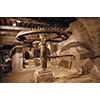
Built quite likely in the late 18th century, this oil-press continued operating until the 1950s. In addition to the oil-press machines that have been integrally conserved - including an outstanding traction-wheel that turned the granite millstone - the collection comprises various tools tied to working olives and producing and selling oil.
Purchased by the Commune in 1990, the oil-press is part of the Museums System of Massa Marittima, created by the Communal Administration and run by the Metalliferous Hills Cooperative.
(Stefania Mangia)
Another testimony of the craftsman’s soul in the historical centre is the Old Carpenter’s Workshop, which exhibits the work tools of carpenters of the area.
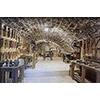
The Old Carpenter’s Workshop is part of the Museums System of Massa Carrara, created by the Communal Administration and run by the Metalliferous Hills Cooperative. It is a faithful reconstruction (1993) of a traditional carpenter’s workshop, and exhibits tools from an old workshop of Gerfalco (Montieri) that for five generations, from the late 19th century to 1990, belonged to the carpenters of the Forgeschi family. The tools were purchased by the Commune of Massa Marittima when the family closed the shop.
(Stefania Mangia)
A natural addition to the city tour is a visit to the excavations of the mining village of Accesa, an ancient Etruscan centre located 10 km from Massa Marittima, which can be reached turning off the road for Gavorrano in the locality of Pesta.
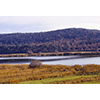
In the midst of a dense woodland area near the Lago dell’Accesa, lie the remains of an ancient Etruscan town, which is still being excavated. The settlement, divided into quarters, was one of a series of small towns in the 6th century B.C. in the area of influence of Vetulonia, sited along itineraries tied to mining activities in the area. The dell’Accesa area is outstanding for having yielded copious evidence of what is today acknowledged as one of the few known urban centres of Etruria.
The chronology of the explored quarters ranges from the late 7th to the 6th century B.C., but the tombs discovered in the area testify to its occupation at least as of the late 9th century B.C.
It is doubtlessly quarter C to hold the greatest interest from the technological point of view. Begun in the first half of the 6th century B.C., it stands out from the others for the presence, on the eastern side, of two groups of furnaces for working metals. Today we can see the craters with concave profile where piles of stones and bricks (with evident signs of exposure to heat) were heaped, mixed with pieces of mineral and a great deal of smelting slag. It appears as no coincidence that the quarter most connoted for handicrafts was also the one closest to the lake: the availability of water was indeed indispensable for the operations of metalworking. The very location of the furnaces, disposed on the border of the inhabited area, would seem to respond to the dictates of the Etrusca disciplina, recalled by Vitruvius in the De architectura (I, 7,1), whereby the areas destined to metallurgical activity had to lie outside of the urban area to avoid the risks of fire.
The buildings brought to light show their foundations formed by local stones such as sandstone or palombino, while the elevations made of unfired bricks, trellises (interlaced branches and reeds, covered with clay) or pisé (fresh clay cast into formwork, which was later removed) have been lost.
Particularly interesting are the technical solutions adopted for water drainage: in addition to the stone ballasts with a honeycomb function, also remarkable is the system of covered raceways, an example of which has survived in house VI of quarter C.
Today a theme park of the Etruscan civilisation, the town can be easily visited with the help of numerous explanatory panels distributed along the itinerary that winds through an uncontaminated nature. An indispensable complement to an outing at the "Lago dell’Accesa" Park is a visit to the Archaeological Museum of Massa Marittima, which exhibits finds discovered in the course of almost a century of excavations.
(Elena Fani)
****************************
Texts by Elena Fani
English translation by Victor Beard
Last update 21/ott/2008



 = libraries and archives
= libraries and archives  = scientific research centers
= scientific research centers  = memorial places of scientists
= memorial places of scientists = public health places
= public health places = places of science and worship
= places of science and worship = places of technology
= places of technology  = museums and collections
= museums and collections  = villas and gardens of science
= villas and gardens of science

